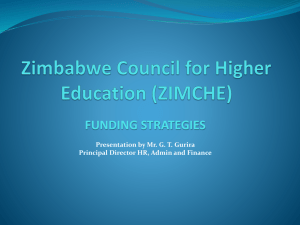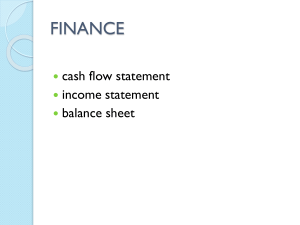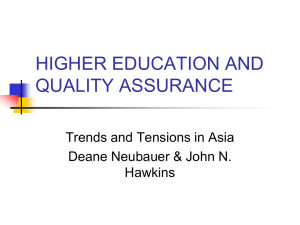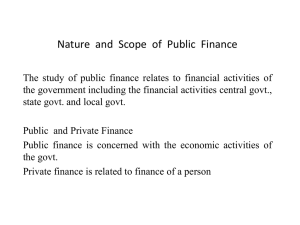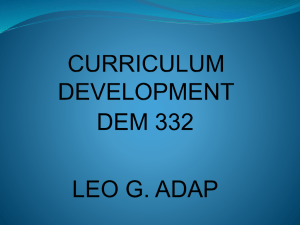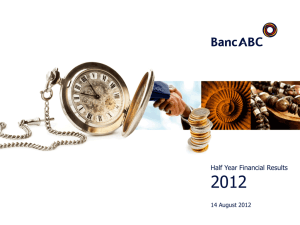HE Funding Frameworks
advertisement
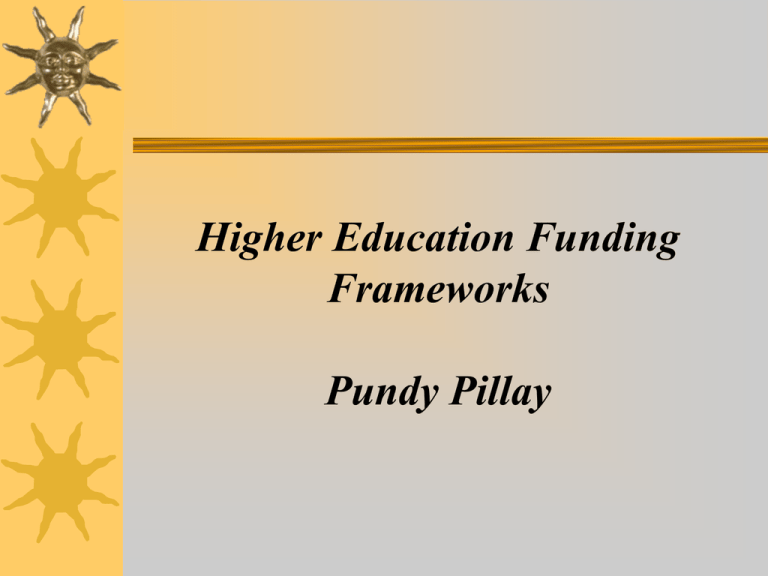
Higher Education Funding Frameworks Pundy Pillay Outline Part One Access and Equity in Higher Education Higher Education and Development Part Two Country Profiles – All SADC countries except Angola, DRC and Malawi Part Three Common Themes, Good Practices, Possible Lessons Access in African Higher Education Defining HE or ‘tertiary’ education Participation rates in SSA generally low, around 5% GER varies from 0.4% in Malawi to 34% in Mauritius Developed countries: 60-70% Developing countries: 16% Equity Gender Socio-economic status Location These 3 stratifying factors skew participation in favour of males richer families, and urban households Barriers to Access Poor and inadequate schooling NER in secondary schooling Developed: 92% Developing: 53% SSA: 25% Contd. Public commitment to HE spending - varies in terms of both % of national income and of the budget - Where HE exp. is low, there are various reasons 1) Educ. exp. is low generally; 2) Schooling is a priority 3) Inter-sectoral competition for resources 4) HE is a low priority Higher education and development The role of higher education is changing with increased globalization HE is now as important for developing, poor countries as it is for rich countries Why? 1) Social returns to HE underestimated 2) Developing countries have multi-modal patterns of economic development 3) HE critical for economic growth and technological absorption HE Funding: Key Questions Public Commitment to HE spending Impact on Access and Equity Funding Mechanisms – institutions, students Budgeting and Planning Processes Efficiency and Effectiveness of HE Financing Special Initiatives Country Profile: Botswana Expenditure as % of GDP high (9%) HE has been “free’ in practice Scholarships to students in private HEIs New university being established on PPP basis Loan system ineffective and inefficient Country Profile: Lesotho High level of govt. funding of HE Government provides very large proportion of institutional funding Govt. funds students thru’ loan/grant scheme No recovery of loans so far but some plans now underway High level of bursary expenditure on students outside country Country Profile: Madagascar Low expenditure on HE even though education takes up 25% of budget High level of government funding of HEIs Nominal tuition fees No funding formula for institutions – allocations on an incremental budgeting basis Country Profile: Mauritius Govt. spending only 25% of all HE expenditure Differentiated government funding model No funding formula – incremental budgeting used by institutions 55% of funding for HE goes from private HHs to overseas HEIs No national student loan scheme but private ones Country Profile: Mozambique High level of exp. on HE Minimal cost sharing – nominal fees Govt. finances quality improvement initiatives in both public and private HEIs HEI funding on the basis of inputs (student numbers) High dependence on donor funding Provincial scholarships for equity Country Profile: Namibia High exp. on education and HE gets 15% National loan scheme benefits relatively few students No clear criteria for funding allocations Cost sharing (fees) introduced Unit costs of HE are high indicating systemic inefficiency Country Profile: South Africa High commitment to public spending on HE Very effective loan scheme Close link between planning and funding Funding formula redistributed to achieve government’s HE objectives Substantial cost-sharing Serious, quality, efficiency and equity issues Country Profile: Swaziland High level of education expenditure – 20% of budget; 6% of GDP High level of government funding of HE (80%) Also relatively high level of tuition fees (20%) No funding formula – govt. assesses institutional budgets Substantial student support – grants and loans Country Profile - Tanzania Educ. exp. as % of budget is high Govt. main funder of HE – institutions and loans Limited cost sharing Significant donor involvement Loans to students in private HEIs No cost recovery of loans TEA provides “soft” loans to both public and private HEIs Country Profile - Zambia Higher education budget is high Poor oversight of HE by MoE No funding formula Dual track tuition with govt.-sponsored and fee-paying students Huge institutional debts New university – state-established but expected to be self-financing Country profile - Zimbabwe Economic crisis – public HEIs not fully developed State funding of infrastructure affected by inflation and currency crisis 95% of recurrent expenditure from state Previous full govt-sponsorship of students replaced by parallel programme Some means-tested grants to needy students Common Themes HE financing is often INADEQUATE, and almost everywhere, INEQUITABLE and INEFFICIENT Enrolments are growing everywhere Serious financial constraints Common Themes (contd.) Responses: Cost-sharing – Namibia, Swaziland, Zambia, Zimbabwe (in some cases, dualtrack) Expansion of private higher education sector Common themes (contd.) Private Higher Education in SADC Serious equity questions Questionable quality – Mozambique; Tanzania; Zambia Absence of regulatory framework to effectively monitor both local and overseas providers Common themes (contd.) Efficiency of HE Expenditure Inefficient because of poor planning and budgeting – Mozambique; Namibia; Tanzania; Madagascar; Zambia Inefficient because of no cost recovery of loans – Botswana; Lesotho; Tanzania No systematic funding mechanism such as funding formula Common Themes (contd.) Inadequacy of Higher Educ. Expenditure • Reasons alluded to earlier • But also because of weak departments of higher education within Ministries of Ed. • Significant involvement of donors in Mozambique and Tanzania, for example – sustainability implications Good practices Financing policies that address inadequacy of public expenditure 1. 2. 3. Public-private partnerships – Botswana; Zambia Differentiated funding model in Mauritius Cost-sharing – Namibia, Swaziland, Zambia, Tanzania, South Africa Good practices (contd.) Financing polices that promote equity 1. Provincial scholarships – Mozambique 2. Loans to students in private HEIs – Botswana, Tanzania 3. Loan scheme to address equity and access – South Africa 4. Funding formula to promote equity – South Africa Good Practices (contd.) Funding policies to promote efficiency 1. Linking HE planning to budgeting – South Africa 2. Funding to improve quality of provision - Mozambique Some Possible Lessons 1. Cost Sharing CS is necessary in most countries in the light of serious public resource constraints CS can take a number of forms Number of advantages and disadvantages to CS Form of CS must minimise impact on equity/inequity Possible Lessons (contd.) 2. Developing efficient and equitable loan scheme Look at South African and Kenyan examples Encouraging signs in Namibia but not anywhere else in SADC Successful loan schemes need some necessary pre-conditions – e.g. efficient tax system Possible lessons (contd.) 3. HE funding formula to promote effectiveness Look at South Africa model for resource allocation in HE Important for the following reasons: predictability of revenue; promoting institutional autonomy and equity; in-built efficiency incentives
